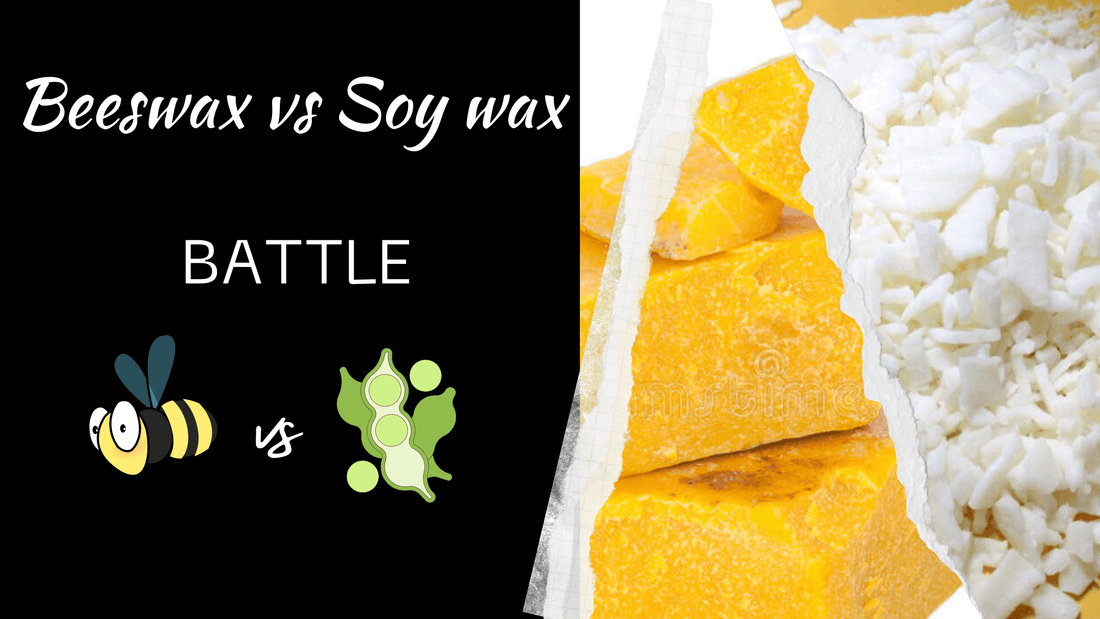Many people don’t know that nowadays there are a couple of different kinds of candles to choose from. The big three are paraffin wax, soy wax, and beeswax candles. Most people have started to turn away from traditional paraffin candles in favor of the other two.
Beeswax and soy wax are two environmentally friendly options for paraffin candles, which have a negative impact on the environment.
But that still leaves soy wax and beeswax candles, and many people wonder, which is the best? Let’s take a look at soy candles vs. beeswax candles!
Beeswax is a wax produced by honeybees of the genus Apis while soy wax is a processed form of soybean oil.
What is beeswax
Beeswax is an all-natural, non-toxic and we can consider it as a cruelty-free and vegetarian product as bees are not harmed in the process of harvesting beeswax. Moreover, beeswax has the lowest toxicity for candle materials; it does not release any toxic byproducts or heavy soot into the air. In fact, beeswax candles, when burned, release negative ions, removing dust, mould, and unpleasant odours. Therefore, they are ideal for those suffering from asthma, hay fever and dust allergies.
Beeswax is a dripless material, making it safer and easier to burn. It also produces a pure and bright light, very close to natural sunlight.
What is Soy Wax
Soy wax candles come from hydrogenated soybean oil, the same source as tofu which, in theory, makes it a more sustainable resource great for those wanting to live the vegan/vegetarian lifestyle. However, the major concern is that at present, 90% of soy is genetically modified, and even 100% soybean oil blends are mixed with vegetable oils like coconut or other waxes. While there are candles that to advertise themselves as paraffin/soy blends those who would prefer truly all-natural options should stay wary. While soy is definitely a better option than paraffin it still has a lot of downsides. Soy wax candles are typically container candles since soy wax has a lower melting point than other types of wax. Moreover, additives can be mixed into soy wax to raise the melting point. In addition, soy wax tends to be softer than paraffin wax.
Difference Between Beeswax and Soy Wax
Definition
Beeswax is a wax produced by honeybees while soy wax is a processed form of soybean oil.
Flame
Beeswax candles produce a more natural light that is within the same spectrum of the sunlight while soy wax candles tend to produce a white flame.
Candle Life
Since beeswax has a higher melting point than soy wax, beeswax candles tend to burn for a longer time.
Scent
Beeswax candles tend to produce a sweeter, more appealing, and more natural scent than soy wax candles. But both can be scented with essential oil mixes.
Price
The most affordable candles will probably always be paraffin, followed by soy, with beeswax candles coming in the last place. But you have to remember, you get what you pay for. A pricier beeswax candle gets you a safe, clean-burning, naturally colored, and naturally scented candle. A less expensive soy candle will get you the strongest scent, richer color palette but will burn less time.
Allergies:
Beeswax candles are free of many of the chemicals found in standard paraffin candles. They also burn brighter and last longer. Note that paraffin is the distillation from petroleum or shale, so breathing it in has been compared to inhaling fumes from a car engine. Soy candles are another natural alternative. Be prepared to pay more for soy and beeswax candles, but they may prove to be a worthwhile investment to maintain your health.


